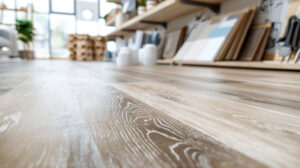
When I first considered installing new ceiling panels, I felt overwhelmed by all the options. I wanted a balance of durability, style, and affordability.
PVC ceiling panels offer easy installation, water resistance, and affordability, making them popular. Yet, they have drawbacks like possible discoloration, limited heat resistance, and concerns over indoor air quality.
I remember feeling unsure if PVC was right for my home. I wanted something low-maintenance but also safe and long-lasting. Let’s explore these panels in detail.
What are the disadvantages of PVC ceiling panels?
When I researched PVC ceiling panels, I realized they are not perfect.
Disadvantages include potential discoloration over time, limited heat resistance, and concerns about chemicals in low-quality panels. Also, some designs may look less natural.
I felt a bit hesitant, but I decided I needed more detailed insight before judging.
Mergulhar mais fundo
Discoloration Issues
PVC panels can fade or turn slightly yellowish after years of exposure to heat or UV light.
- Exposição aos raios UV: Direct sunlight can speed up fading.
- Heat Spots: Near kitchen ceilings, heat may cause subtle color changes.
Limited Heat Resistance
PVC does not tolerate very high temperatures.
- Deformation Risk: Extreme heat can warp panels.
- Not Fireproof: While some panels have fire-retardant treatments, they are still plastic-based.
Potential Chemical Emissions
Some low-quality PVC panels can release volatile organic compounds (VOCs).
- Indoor Air Quality Concerns: Poor ventilation may trap these chemicals.
- Avoiding Cheap Products: Choosing certified, reputable brands helps reduce risks. Learn more about the potential chemical concerns of PVC1
Maintenance and Appearance
While easy to clean, PVC may not provide the rich, textured look of wood or gypsum.
- Artificial Look: Some panels lack authenticity.
- Scratches and Stains: Strong abrasives can dull the finish.
| Desvantagem | Impacto | Mitigação |
|---|---|---|
| Descoloração | Reduced visual appeal | UV-resistant panels, less direct sunlight |
| Sensibilidade ao calor | Possible warping | Avoid high-heat fixtures nearby |
| Emissões químicas | Indoor air concerns | Choose low-VOC certified brands |
| Artificial Look | Less natural finish | Select high-quality textures |
How long will a PVC ceiling last?
I needed to know if PVC was a long-term solution or a short-term fix.
A PVC ceiling can last 10 to 20 years, depending on material quality, exposure to heat or UV, and overall maintenance efforts.
This sounded promising. If well-chosen and properly maintained, it could outlast other budget options.
Mergulhar mais fundo
Durability Factors
- Espessura do material: Thicker panels resist dents and cracks better.
- Quality of Production: High-quality PVC ensures stable color and shape over time.
Condições ambientais
- Humidade e humidade: PVC resists moisture but extreme humidity may shorten lifespan slightly.
- Flutuações de temperatura: Consistent indoor climate helps maintain panel integrity.
Hábitos de manutenção
- Limpeza regular: Gentle wiping prevents dust buildup, maintaining appearance.
- Avoiding Harsh Cleaners: Mild detergents keep surfaces smooth and intact.
Comparing Lifespans
- PVC vs. Wood: Wood can last longer but may need more care. PVC is more stable in humid areas.
- PVC vs. Gypsum: Gypsum might crack with impact, whereas PVC stays intact if well installed.
| Fator | Effect on Lifespan | Action to Extend Life |
|---|---|---|
| Qualidade do material | Higher quality lasts longer | Invest in premium panels |
| Controlo ambiental | Stable indoor climate prevents warping | Regulate temperature/humidity |
| Rotina de limpeza | Prevents discoloration and dulling | Use gentle methods only |
Does PVC ceiling get damaged by water?
I worried about leaks or spills from the floor above.
PVC ceiling panels are water-resistant, making them unlikely to warp or rot when exposed to moisture. They can handle damp conditions better than many other materials.
This was reassuring, especially if placed in bathrooms or kitchens.
Mergulhar mais fundo
Water Resistance Explained
PVC is inherently non-porous, so it does not absorb water.
- Sem inchaço: Unlike wood, PVC won’t swell or crack from humidity.
- No Mold Growth: Limited moisture absorption means fewer mold issues.
Handling Leaks
- Minor Leaks: Wiping the surface is often enough.
- Serious Water Damage: Prolonged contact might loosen fixtures or weaken support structures, but the PVC itself usually stays intact.
Cleaning After Exposure
- Limpeza simples: A damp cloth removes water stains easily.
- Avoid Strong Chemicals: Non-porous means easy cleaning with mild solutions.
Comparisons
- PVC vs. Metal Panels: Metal can rust if exposed to water, PVC does not.
- PVC vs. Plasterboard: Plasterboard can crumble when wet, PVC remains stable.
| Aspeto | PVC Behavior in Water | Result |
|---|---|---|
| Absorption | No absorption | No swelling or warping |
| Resistência ao bolor | Less prone to mold growth | Healthier environment |
| Manutenção | Easy cleaning | Quick recovery after leaks |
What are the disadvantages of PVC?
I needed to consider PVC as a material, not just for ceilings but in general.
PVC’s disadvantages include concerns over chemical content, lower heat tolerance, and a synthetic appearance that may not match natural aesthetics. Its production can also raise environmental issues.
This reminded me that PVC, while handy, is still a plastic product with inherent limitations.
Mergulhar mais fundo
Chemical Makeup
PVC is made from vinyl chloride, a synthetic polymer.
- Potential Toxins: Poorly made PVC might release harmful chemicals.
- Regulatory Standards: Better brands follow strict guidelines to limit emissions. Learn more about PVC’s chemical makeup2
Preocupações ambientais
- Non-Renewable Resources: PVC comes from petroleum-based sources.
- Difficult Recycling: PVC recycling is less straightforward than other plastics. Discover PVC’s environmental impact3
Heat Limitations
- Softening Under Heat: At high temperatures, PVC can warp or release odors.
- Not Suitable Near Stoves: PVC ceilings in kitchens should be installed away from direct heat.
Durability vs. Natural Materials
- Less Resilient than Metal: Under extreme conditions, metal might last longer.
- Less Authentic than Wood: Aesthetic preferences may lean toward natural materials.
| Desvantagem | Descrição | Considerações |
|---|---|---|
| Chemical Concerns | Potential VOCs, toxins | Choose certified PVC |
| Impacto ambiental | Petroleum-based, hard to recycle | Limit use or dispose properly |
| Sensibilidade ao calor | Warps under high heat | Avoid direct heat sources |
| Limitações estéticas | Synthetic look | Opt for textured finishes |
What are the side effects of PVC panels?
I thought about health implications and indoor comfort.
Side effects can include slight chemical odors after installation and potential VOC emissions, especially from low-quality panels. Some people may experience headaches or irritation if ventilation is poor.
This made me cautious. I would ensure proper ventilation.
Mergulhar mais fundo
VOC Emissions and Odors
- Initial Smell: New PVC panels may release a mild plastic smell.
- Ventilation Is Key: Good airflow helps dissipate odors quickly.
Allergies and Sensitivities
- Respiratory Irritation: Sensitive individuals might feel discomfort if VOC levels are high.
- Eye or Throat Irritation: Proper selection and installation minimize these risks.
Long-Term Exposure
- Questões de qualidade: Certified panels often emit fewer chemicals over time.
- Manutenção regular: Dust and clean panels to keep the environment fresh and safe.
Comparisons
- PVC vs. Other Plastics: Many plastics emit some VOCs, but well-made PVC can be low-odor.
- PVC vs. Painted Surfaces: Some paints also emit VOCs, so PVC may not be worse than certain paints.
| Side Effect | Causa | Mitigação |
|---|---|---|
| Mild Odors | New panel installation | Ventilate room well |
| Emissões de COV | Low-quality PVC materials | Choose certified brands |
| Irritation | Sensitive individuals exposed to VOCs | Keep space ventilated, regular cleaning |
Is PVC good for ceilings?
With all these details in mind, I wondered if PVC was actually a good choice.
PVC is a practical option for ceilings due to its water resistance, easy installation, and low maintenance. Yet, some may dislike its synthetic look and possible VOC emissions.
I appreciated the durability and easy care. In the right setting, PVC can be a good fit.
Mergulhar mais fundo
Ideal Environments
- Bathrooms and Kitchens: Moisture resistance makes PVC panels shine.
- Caves: Damp conditions do not affect them much.
Aesthetic Upgrades
- Textured Finishes: Some panels mimic wood grain or stone patterns, increasing visual appeal.
- Color Choices: A wide range of colors helps match any décor.
Custo e instalação
- Budget-Friendly: PVC panels are often cheaper than wood or metal.
- Potencial de bricolage: Lightweight and easy to cut, installation can be simpler than heavy materials.
Equilíbrio entre prós e contras
- Prós: Affordable, moisture-proof, easy to clean, good variety.
- Contras: Synthetic feel, not fireproof, possible chemical concerns.
| Aspeto | PVC Performance | Overall Suitability |
|---|---|---|
| Resistência à humidade | Excelente | Great for damp areas |
| Manutenção | Low-effort | Good for busy homeowners |
| Custo | Generally low | Suits tight budgets |
| Aparência | Synthetic, varied finishes | Consider personal style |
Conclusão
PVC ceiling panels provide an affordable, easy-to-install, and moisture-resistant solution. They can last for many years with minimal care. However, they may not satisfy everyone’s aesthetic tastes, and potential VOC emissions raise concerns for some homeowners. By choosing high-quality, certified panels and ensuring proper ventilation, many of these drawbacks can be reduced.
In my case, weighing the pros and cons helped me decide if PVC suited my personal style and comfort needs. For areas like bathrooms or kitchens, PVC might be perfect. For living rooms or bedrooms, I might prefer a more natural-looking material. It all comes down to personal priorities and the environment you want to create.
-
Learn about PVC’s potential chemical concerns, including harmful VOCs and how to minimize risks by choosing certified products. ↩
-
Discover how PVC is made from vinyl chloride and the potential risks of low-quality products, including chemical emissions. ↩
-
Understand PVC’s environmental impact, from its petroleum-based production to challenges with recycling. ↩


